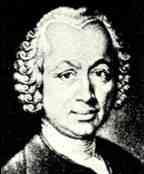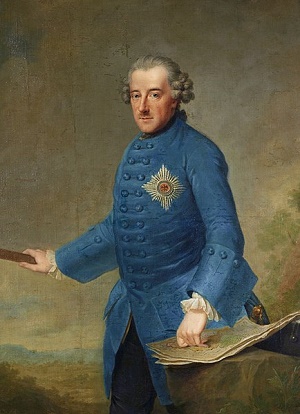


Franz Benda
Source: Radio Swiss Classic
Martin Luther's divisive '95 Theses' had been published in Germany in 1517 amidst the Holy Roman Empire (HRE), the latter allied in Spain and like Venice to the Catholic Papacy in Rome. The Lutheran faith had managed to take hold within the HRE due to an alliance of German powers called the Schmalkaldic League formed on 27 February 1531 by Elector of Saxony, John Frederick I, and Landgrave of Hesse, Philip I. The intention of this union was to replace Catholicism with Protestantism throughout the Empire. The Peace of Augsburg in 1555 between Holy Roman Emperor, Charles V, and the Schmalkaldic League could not address continuing disputes as the Protestant religion grew throughout Europe, leading to the Thirty Years War (1618-1648). With pockets of the Protestant religion arising elsewhere such as in Belgium (Netherlands) and France, the whole of confoundingly interlaced Europe escalated in reasons for conflict, occasioning the Eighty Years War (Dutch vs Habsburgs in Netherlands), the War of the Mantuan Succession (France vs Spain), the Franco-Spanish War, the Torstenson War (Sweden vs Denmark-Norway), the Dutch-Portuguese War and the Portuguese Restoration War. The Thirty Years War ended with Habsburg Holy Roman Emperor, Ferdinand III, taking a good portion of Prague's population to Vienna with him upon the Peace of Westphalia in 1648. Prague was capitol of Bohemia now in the Czech Republic just west of southern Poland. All combined, the Thirty Years War had cost Prague two thirds of its population to either sword or evacuation. The region didn't rebuild in a day and continued to be contested during Czech composer, Franz Benda's, lifetime.

John Frederick I of Saxony
Protector of the infant Protestant faith within the Catholic Holy Roman Empire
Painting by Lucas Cranach the Elder 1532
Source: Wikipedia

Philip I of Hesse
Protector of the infant Protestant faith within the Catholic Holy Roman Empire
Painting by Hans Krell 1534
Source: Wikipedia
Protestantism wasn't the only headache which the Catholic Habsburgs faced. They had fought off the Ottoman incursion in Spain throughout the 16th century, no thanks to France which had allied with the Muslims, preferring to face them over the powerful House of Habsburg which had built its first castle in Switzerland (1291) in the early 11th century. The Habsburgs again repelled the Ottoman Empire on its eastern front at the Battle of Vienna in 1683. Though this may conceivably have been salvation to all of Europe the HRE continued to face hostility from Bavaria, Prussia and France. Thirty years later in April 1713, when Franz Benda was a toddler three years of age, Emperor Charles VI formed his Pragmatic Allies of Great Britain (1707), the Dutch Republic (1597), and Hanover in Germany to ensure the right of succession for his daughter, Maria Theresa. Regardless, come the War of the Austrian Succession from 1740-1748 commencing the Silesian Wars consisting of three to as late as the end of the third in 1763, those fought between Maria Theresa's Austria and the Prussia of Frederick II (Frederick the Great). Such the embattled Europe into which Benda was born and lived.

Frederick II the Great of Prussia
Nemesis to Holy Roman Empress Maria Theresa of Austria
Painting by Johann Georg Ziesenis 1763
Source: Wikipedia

Holy Roman Empress Maria Theresa of Austria
Nemesis to Frederick II the Great of Prussia
Painting by Martin van Meytens 1759
Source: Wikipedia
Czech composer, Jan Dismas Zelenka, was about thirty years older than Benda. Frantisek Tůma was only five years older. Baptized 22 November 1709 in Benátky nad Jizerou, Bohemia, Franz Benda, was elder brother to musicians, Johann Georg Benda, Georg Antonín Benda and Joseph Benda, Protestant sons of the Protestant weaver, Jan Jiri Benda. His sister, Anna Franziska, was an operatic soprano. Benda was a chorister as a child in Prague and Dresden. Upon starting to play violin he joined a group of strolling musicians until 1730, going to Vienna to study under Carl Graun. In 1732 he entered into the service of Frederick II with whom he kept the remaining fifty-four years of his career. Frederick was not only a notable military strategist, but a composer as well. He favored Protestantism, tolerated Catholicism, and was himself a Freemason.
The First Silesian War of 1740-1742 saw Frederick II seizing Silesia in southwest Poland from Austria. To solidify that gain Frederick invaded Prague in 1744 per the Second Silesian War. That was a three-day siege only as destructive as needful, life to go on much as before [Battle of Prague]. Albeit Frederick sustained huge losses at Prague he was a minimalist commander insofar as his interests were in building the city rather than razing it. He was among the better enemies to have even if you were a Pole: Frederick was German and owned a considerable bias concerning the stubborn and unenlightened Polish, to become disgust upon having to go another round against Austria in a Third Silesian War from 1756 to 1763 to further confirm his hold on Silesia. Be as may, the gradual rebuilding of Prague by Frederick finally brought inclusive rivalry with the rest of Europe and firmly put Czech composers on the map.
The 'New International Encyclopedia' of 1905 states that Benda performed some 50,000 "concertos" during a forty year period with Frederick. That's above 1,200 a year, 100 per month or three per day, thus dubitable. Benda was, nevertheless, retained by Frederick because he was among the finest violinists in Europe at the time. His compositions were catalogued by Douglas A. Lee in 1984 in 'Franz Benda (1709-1789): A Thematic Catalogue of His Works' (Pendragon Press). L I:1-17 are symphonies. L II:1-28 are concertos. L III:1-182 are violin sonatas with continuo. L IV:1-10 are trio sonatas. L V:1-31 are violin duets. L VI:1-110 are for solo violin. L VII:1-3 are miscellaneous works. Dates for Benda's compositions are unidentified. Works below descend per Lee numbers which are not chronological.
'Sinfonia in C major' L 1:1 Franz Benda Sometime 1740-55
Tříkrálový Koncert Orchestru
'Violin Concerto in D minor' L 2:4 Version for violin Franz Benda
Violin: Ariane Pfister Suk Chamber Orchestra Christian Benda
'Flute Concerto in E Minor' L 2:4 Version for flute Franz Benda
Flute: Eugenia Zukerman Slovak Chamber Orchestra Bohdan Warchal
'Flute Concerto in G major' L 2:11 Franz Benda
Flute: Vera Balogh Savaria Baroque Orchestra Pál Németh
'Violin Concerto in A major' L 2:13 Franz Benda Sometime 1740-55
Violin: Zefira Valova Il Pomo d'Oro
'Violin Sonata in C major' L 3:2 Franz Benda
Violin: Anton Steck Harpsichord (continuo): Christian Rieger
'Violin Sonata in E-flat major' L 3:40 Franz Benda
Violin: Anton Steck Harpsichord (continuo): Christian Rieger
'Violin Sonata in F major' L 3:63 Franz Benda
Violin: Anton Steck Harpsichord (continuo): Christian Rieger
'Violin Sonata in A minor' L 3:118 Franz Benda
Violin: Evgeny Sviridov
Cello (continuo): Marie-Louise Wundling
Theorbo (continuo): Liza Solovey
'Violin Sonata in A minor' L 3:121 Franz Benda
Violin: Anton Steck Harpsichord (continuo): Christian Rieger
Frederick's lifelong bane, Maria Theresa, died on 29 November 1780 at age 63. Benda followed on 7 March 1786, Frederick on 17 August at age 74.
Further Sources & References for Franz Benda:
Aryeh Oron (Bach Cantatas)
VF History (notes)
Audio of Benda: Classical Archives Naxos Presto
Recordings of Benda: Catalogs: Discos Music Brainz REM
Recordings of Benda: Select:
J.A. Benda | F. Benda by the Suk & Prague Chamber Orchestras directed by Christian Benda:
Scores / Sheet Music: Corpus:
IMSLP Internet Archive Musicalics (vendor) ScorSer
Further Reading:
Habsburg Holy Roman Empire vs the Ottoman Empire: Wikipedia
Authority Search: VIAF
Classical Main Menu Modern Recording
hmrproject (at) aol (dot) com